过去完成时态教案
- 格式:pdf
- 大小:7.54 KB
- 文档页数:2
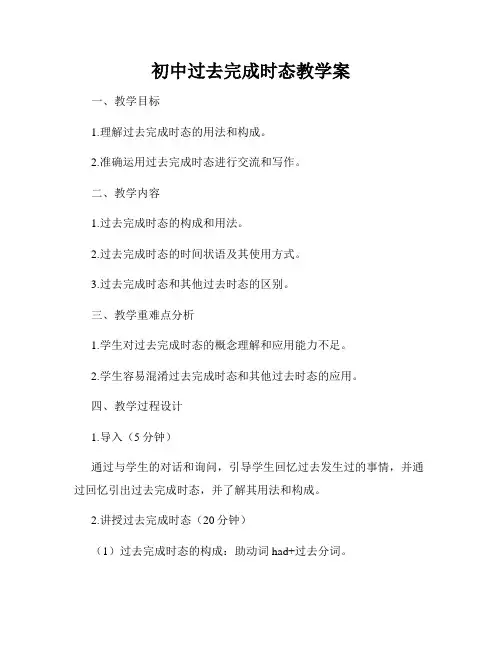
初中过去完成时态教学案一、教学目标1.理解过去完成时态的用法和构成。
2.准确运用过去完成时态进行交流和写作。
二、教学内容1.过去完成时态的构成和用法。
2.过去完成时态的时间状语及其使用方式。
3.过去完成时态和其他过去时态的区别。
三、教学重难点分析1.学生对过去完成时态的概念理解和应用能力不足。
2.学生容易混淆过去完成时态和其他过去时态的应用。
四、教学过程设计1.导入(5分钟)通过与学生的对话和询问,引导学生回忆过去发生过的事情,并通过回忆引出过去完成时态,并了解其用法和构成。
2.讲授过去完成时态(20分钟)(1)过去完成时态的构成:助动词had+过去分词。
(2)过去完成时态的用法:表示在过去某个时间或某种情况发生的动作或状态已经完成。
(3)过去完成时态的时间状语及使用方式:by+过去时间点或before+过去时间点表示过去完成时态的时间状语,在by和before后面的过去时间点表示的是过去的某个时间点。
3.练习过去完成时态(30分钟)(1)学生进行句子翻译,使用过去完成时态翻译句子。
(2)学生进行问答练习,进行情景模拟,运用过去完成时态进行回答。
4.过去完成时态与其他过去时态的区别(20分钟)比较过去完成时态、简单过去时和过去进行时的区别,比较三种时态的语态结构、含义和使用范围。
5.作业布置(5分钟)完成相应的练习题,加深对过去完成时态的理解和掌握。
五、教学评价1.教师通过对学生的提问和讨论检测学生对过去完成时态的理解和应用。
2.针对学生在学习过程中出现的问题和困难,加以及时解答和帮助。
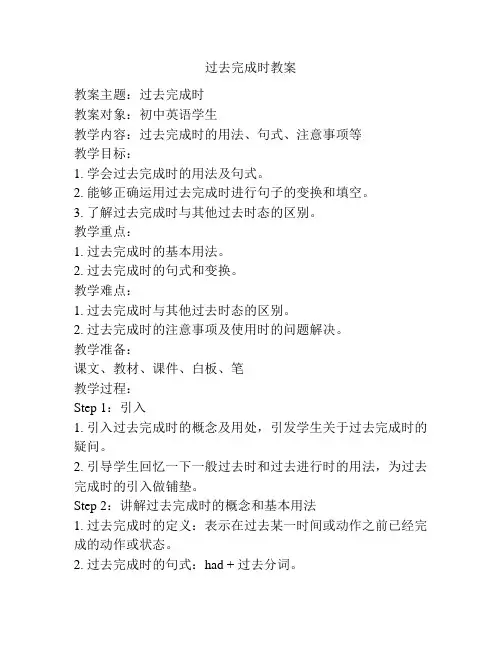
过去完成时教案教案主题:过去完成时教案对象:初中英语学生教学内容:过去完成时的用法、句式、注意事项等教学目标:1. 学会过去完成时的用法及句式。
2. 能够正确运用过去完成时进行句子的变换和填空。
3. 了解过去完成时与其他过去时态的区别。
教学重点:1. 过去完成时的基本用法。
2. 过去完成时的句式和变换。
教学难点:1. 过去完成时与其他过去时态的区别。
2. 过去完成时的注意事项及使用时的问题解决。
教学准备:课文、教材、课件、白板、笔教学过程:Step 1:引入1. 引入过去完成时的概念及用处,引发学生关于过去完成时的疑问。
2. 引导学生回忆一下一般过去时和过去进行时的用法,为过去完成时的引入做铺垫。
Step 2:讲解过去完成时的概念和基本用法1. 过去完成时的定义:表示在过去某一时间或动作之前已经完成的动作或状态。
2. 过去完成时的句式:had + 过去分词。
3. 过去完成时的用法:a. 主要用于描写先后发生的过去动作或状态。
b. 强调过去某一时间或动作之前已经完成的动作或状态。
4. 通过实例来讲解过去完成时的用法。
Step 3:练习1. 给学生一些使用过去完成时的句子,要求学生用过去完成时进行句子的变换。
2. 给学生一些填空题,要求学生用适当的过去完成时形式完成句子。
Step 4:知识拓展1. 与其他过去时态的区别:过去完成时表示在过去某一时间或动作之前已经完成的动作或状态,而一般过去时和过去进行时则表示在过去某一时间的动作或状态。
2. 提醒学生注意过去完成时的特殊句式和异常用法。
Step 5:总结归纳1. 与学生一起总结过去完成时的用法、句式以及注意事项。
2. 强调学生在实际运用中需要注意的问题。
Step 6:作业布置1. 布置一些关于过去完成时的作业,巩固学生的知识掌握。
2. 布置一些写作练习,要求学生运用过去完成时进行句子的叙述。
教学反思:通过本次教学过程,学生能够了解到过去完成时的基本概念和用法,并能正确运用过去完成时进行句子的变换和填空。
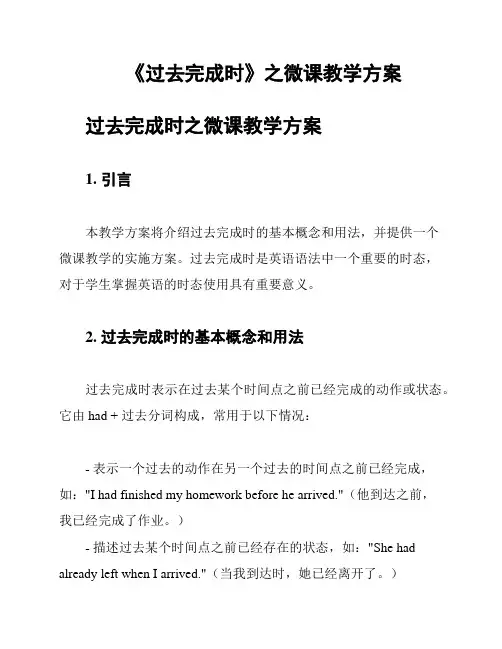
《过去完成时》之微课教学方案过去完成时之微课教学方案1. 引言本教学方案将介绍过去完成时的基本概念和用法,并提供一个微课教学的实施方案。
过去完成时是英语语法中一个重要的时态,对于学生掌握英语的时态使用具有重要意义。
2. 过去完成时的基本概念和用法过去完成时表示在过去某个时间点之前已经完成的动作或状态。
它由had + 过去分词构成,常用于以下情况:- 表示一个过去的动作在另一个过去的时间点之前已经完成,如:"I had finished my homework before he arrived."(他到达之前,我已经完成了作业。
)- 描述过去某个时间点之前已经存在的状态,如:"She had already left when I arrived."(当我到达时,她已经离开了。
)过去完成时通常和过去简单时或过去进行时配合使用,以表达更精确的时间关系。
3. 微课教学方案3.1 教学目标- 理解过去完成时的基本概念和用法- 能正确运用过去完成时进行句子构造和语句转换- 能在实际语境中正确运用过去完成时3.2 教学内容- 过去完成时的基本概念- 过去完成时的构成方法- 过去完成时的常见句型和用法3.3 教学步骤1. 导入:引发学生对过去完成时的兴趣,可以通过一个已经发生的故事开头来引出过去完成时的概念。
2. 介绍过去完成时的概念和构成方法:通过简单的例子和语法解释,让学生了解过去完成时的基本概念和构成方法。
3. 案例分析:以实际案例为例,让学生分析句子中出现的过去完成时,并解释其用法和意义。
4. 练:提供一些练题,让学生在课堂上进行个人或小组练,巩固对过去完成时的理解和应用能力。
5. 拓展活动:通过组织小组讨论或个人写作等形式,让学生在实际语境中运用过去完成时。
3.4 教学评价通过课堂练和拓展活动的表现,评价学生对过去完成时的掌握情况和应用能力。
4. 结语通过本教学方案的实施,学生将能够理解过去完成时的基本概念和用法,并能够在实际语境中正确运用。
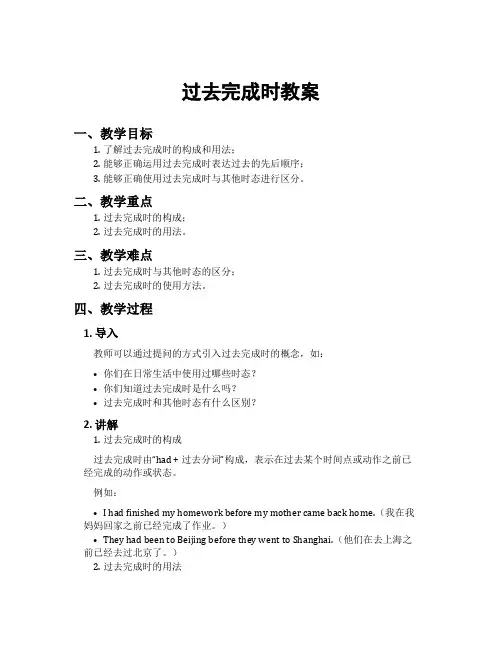
过去完成时教案一、教学目标1.了解过去完成时的构成和用法;2.能够正确运用过去完成时表达过去的先后顺序;3.能够正确使用过去完成时与其他时态进行区分。
二、教学重点1.过去完成时的构成;2.过去完成时的用法。
三、教学难点1.过去完成时与其他时态的区分;2.过去完成时的使用方法。
四、教学过程1. 导入教师可以通过提问的方式引入过去完成时的概念,如:•你们在日常生活中使用过哪些时态?•你们知道过去完成时是什么吗?•过去完成时和其他时态有什么区别?2. 讲解1.过去完成时的构成过去完成时由“had + 过去分词”构成,表示在过去某个时间点或动作之前已经完成的动作或状态。
例如:•I had finished my homework before my mother came back home.(我在我妈妈回家之前已经完成了作业。
)•They had been to Beijing before they went to Shanghai.(他们在去上海之前已经去过北京了。
)2.过去完成时的用法过去完成时通常用于以下情况:•表示在过去某个时间点或动作之前已经完成的动作或状态;•表示过去某个时间点或动作之前的持续状态;•表示过去某个时间点或动作之前的结果。
例如:•I had studied English for 5 years before I went to America.(我在去美国之前已经学了5年英语。
)•She had been waiting for the bus for half an hour before it finally arrived.(她在公交车到达之前已经等了半个小时了。
)•He had lost his key, so he couldn’t get into the house.(他丢了钥匙,所以进不了房子。
)3. 练习1.选择题2.I _______ my breakfast before I went to school. A. had B. have C. has D. having3.She _______ her homework before she watched TV. A. had finished B. finishedC. has finishedD. finishing4.They _______ to the cinema before they went to the park. A. had been B. havebeen C. has been D. being5.He _______ his phone at home, so he couldn’t answer the call. A. had left B. leftC. has leftD. leaving6.We _______ the movie before it started to rain. A. had seen B. saw C. have seenD. seeing7.句子翻译8.我们已经吃过晚饭了,所以我们去看电影了。
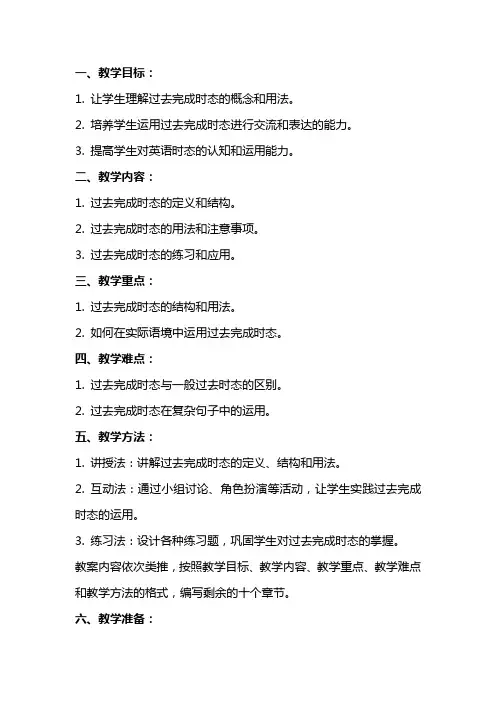
一、教学目标:1. 让学生理解过去完成时态的概念和用法。
2. 培养学生运用过去完成时态进行交流和表达的能力。
3. 提高学生对英语时态的认知和运用能力。
二、教学内容:1. 过去完成时态的定义和结构。
2. 过去完成时态的用法和注意事项。
3. 过去完成时态的练习和应用。
三、教学重点:1. 过去完成时态的结构和用法。
2. 如何在实际语境中运用过去完成时态。
四、教学难点:1. 过去完成时态与一般过去时态的区别。
2. 过去完成时态在复杂句子中的运用。
五、教学方法:1. 讲授法:讲解过去完成时态的定义、结构和用法。
2. 互动法:通过小组讨论、角色扮演等活动,让学生实践过去完成时态的运用。
3. 练习法:设计各种练习题,巩固学生对过去完成时态的掌握。
教案内容依次类推,按照教学目标、教学内容、教学重点、教学难点和教学方法的格式,编写剩余的十个章节。
六、教学准备:1. 教学PPT或黑板,用于展示过去完成时态的定义、结构和用法。
2. 练习题和答案,用于巩固学生对过去完成时态的掌握。
3. 教学素材,如故事、图片等,用于创设语境,让学生在实际情景中运用过去完成时态。
七、教学过程:1. 导入:通过提问,引导学生回顾一般过去时态,为新课的学习做好铺垫。
2. 讲解:详细讲解过去完成时态的定义、结构和用法,让学生明确概念。
3. 示例:给出一些过去完成时态的例句,让学生观察并分析其结构特点。
4. 练习:设计一些练习题,让学生巩固过去完成时态的用法。
5. 应用:创设实际语境,如故事、角色扮演等,让学生在实践中运用过去完成时态。
八、课堂小结:1. 回顾过去完成时态的定义、结构和用法。
2. 强调在实际语境中运用过去完成时态的重要性。
3. 鼓励学生在日常生活中多练习使用过去完成时态。
九、课后作业:1. 完成课后练习题,巩固对过去完成时态的掌握。
2. 运用过去完成时态编写一个小故事,展示自己的实际应用能力。
十、教学反思:1. 总结本节课的教学效果,如学生对过去完成时态的掌握程度。
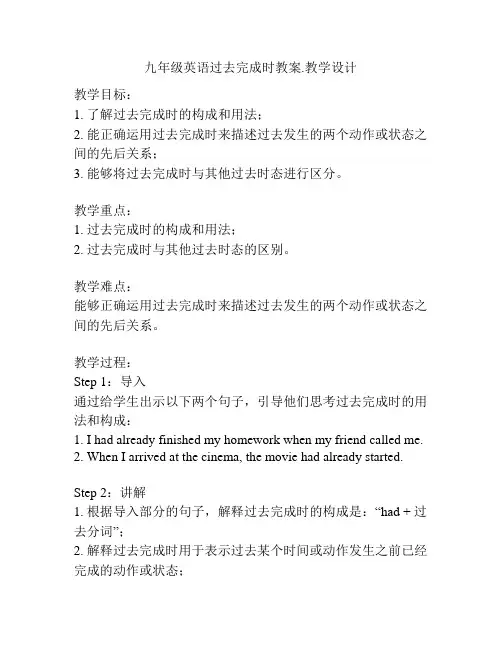
九年级英语过去完成时教案.教学设计教学目标:1. 了解过去完成时的构成和用法;2. 能正确运用过去完成时来描述过去发生的两个动作或状态之间的先后关系;3. 能够将过去完成时与其他过去时态进行区分。
教学重点:1. 过去完成时的构成和用法;2. 过去完成时与其他过去时态的区别。
教学难点:能够正确运用过去完成时来描述过去发生的两个动作或状态之间的先后关系。
教学过程:Step 1:导入通过给学生出示以下两个句子,引导他们思考过去完成时的用法和构成:1. I had already finished my homework when my friend called me.2. When I arrived at the cinema, the movie had already started.Step 2:讲解1. 根据导入部分的句子,解释过去完成时的构成是:“had + 过去分词”;2. 解释过去完成时用于表示过去某个时间或动作发生之前已经完成的动作或状态;3. 解释过去完成时与其他过去时态的区别。
Step 3:练习1. 配对练习:让学生分成小组进行配对练习,给出一对情景,要求他们用过去完成时来描述这两个情景发生的先后关系。
例如:- Tom arrived at the party. He ate 5 pieces of cake.- Amy arrived at the party. She ate 3 pieces of cake.答案:Amy had already eaten 3 pieces of cake when Tom arrived at the party.2. 补全句子:给学生提供一些句子,让他们补全使用过去完成时的部分。
例如:- By the time they arrived, the party _______ already _______.答案:had, started.- I ________ already ________ my homework when my mom came home.答案:had, finished.Step 4:巩固1. 完成练习册中关于过去完成时的练习题;2. 写一篇关于自己上周末的日记,要求使用过去完成时来描述你已经完成的活动。
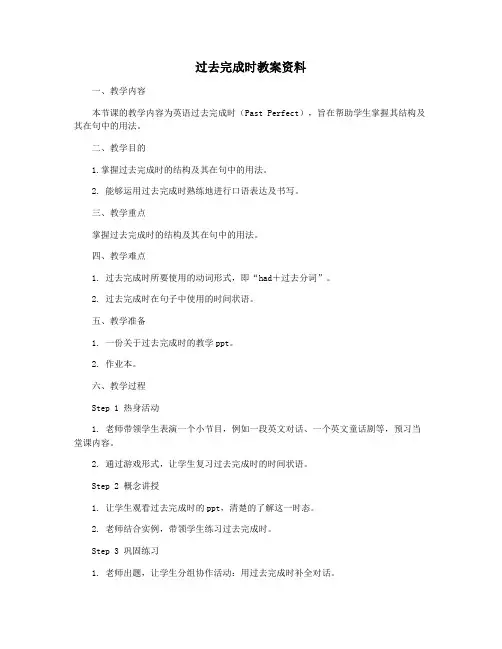
过去完成时教案资料
一、教学内容
本节课的教学内容为英语过去完成时(Past Perfect),旨在帮助学生掌握其结构及其在句中的用法。
二、教学目的
1.掌握过去完成时的结构及其在句中的用法。
2. 能够运用过去完成时熟练地进行口语表达及书写。
三、教学重点
掌握过去完成时的结构及其在句中的用法。
四、教学难点
1. 过去完成时所要使用的动词形式,即“had+过去分词”。
2. 过去完成时在句子中使用的时间状语。
五、教学准备
1. 一份关于过去完成时的教学ppt。
2. 作业本。
六、教学过程
Step 1 热身活动
1. 老师带领学生表演一个小节目,例如一段英文对话、一个英文童话剧等,预习当堂课内容。
2. 通过游戏形式,让学生复习过去完成时的时间状语。
Step 2 概念讲授
1. 让学生观看过去完成时的ppt,清楚的了解这一时态。
2. 老师结合实例,带领学生练习过去完成时。
Step 3 巩固练习
1. 老师出题,让学生分组协作活动:用过去完成时补全对话。
2. 让学生讨论:它与过去时的区别。
七、课后作业
1. 让学生回答以下问题:过去完成时能表示什么时间?
2. 让学生运用过去完成时书写一段话。
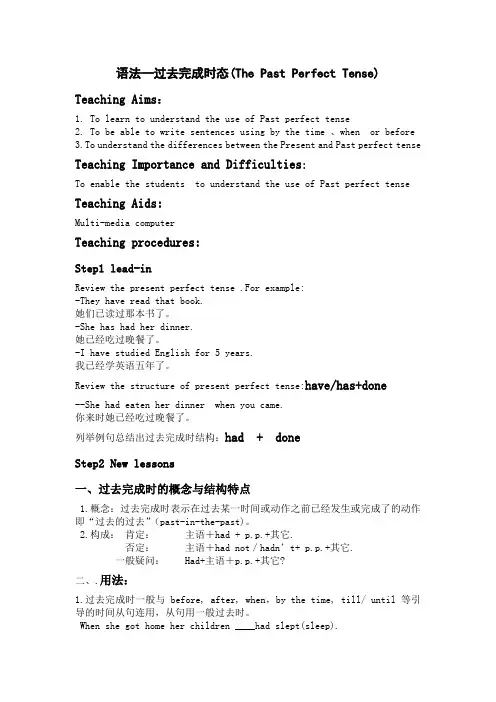
语法—过去完成时态(The Past Perfect Tense) Teaching Aims:1. To learn to understand the use of Past perfect tense2. To be able to write sentences using by the time 、when or before3.To understand the differences between the Present and Past perfect tense Teaching Importance and Difficulties:To enable the students to understand the use of Past perfect tense Teaching Aids:Multi-media computerTeaching procedures:Step1 lead-inReview the present perfect tense .For example:-They have read that book.她们已读过那本书了。
-She has had her dinner.她已经吃过晚餐了。
-I have studied English for 5 years.我已经学英语五年了。
Review the structure of present perfect tense:have/has+done--She had eaten her dinner when you came.你来时她已经吃过晚餐了。
列举例句总结出过去完成时结构:had + doneStep2 New lessons一、过去完成时的概念与结构特点1.概念:过去完成时表示在过去某一时间或动作之前已经发生或完成了的动作即“过去的过去”(past-in-the-past)。
2.构成:肯定:主语+had + p.p.+其它.否定:主语+had not/hadn’t+ p.p.+其它.一般疑问: Had+主语+p.p.+其它?二、.用法:1.过去完成时一般与before, after, when,by the time, till/ until 等引导的时间从句连用,从句用一般过去时。
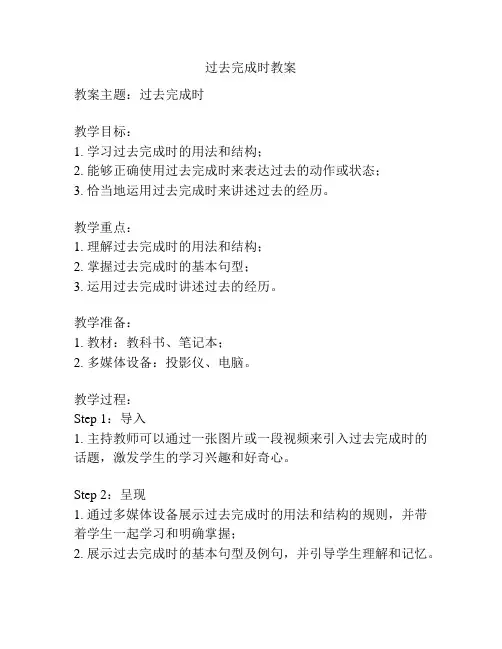
过去完成时教案教案主题:过去完成时教学目标:1. 学习过去完成时的用法和结构;2. 能够正确使用过去完成时来表达过去的动作或状态;3. 恰当地运用过去完成时来讲述过去的经历。
教学重点:1. 理解过去完成时的用法和结构;2. 掌握过去完成时的基本句型;3. 运用过去完成时讲述过去的经历。
教学准备:1. 教材:教科书、笔记本;2. 多媒体设备:投影仪、电脑。
教学过程:Step 1:导入1. 主持教师可以通过一张图片或一段视频来引入过去完成时的话题,激发学生的学习兴趣和好奇心。
Step 2:呈现1. 通过多媒体设备展示过去完成时的用法和结构的规则,并带着学生一起学习和明确掌握;2. 展示过去完成时的基本句型及例句,并引导学生理解和记忆。
Step 3:练习1. 分发练习题,让学生根据句意填写正确的过去完成时形式;2. 在学生完成练习后,进行批改和解析,纠正他们的错误并解答疑惑。
Step 4:拓展1. 让学生分组进行小组活动,让每个小组成员在过去完成时的情况下轮流问问题和回答问题,以练习和巩固过去完成时的用法和结构;2. 结束小组活动后,让每个小组选一位学生代表表演他们的对话,以展示他们的学习成果。
Step 5:归纳1. 主持教师总结过去完成时的用法和结构,并强调细节和要点,确保学生理解和掌握;2. 让学生记下重点内容,以便复习和记忆。
Step 6:作业布置1. 布置相关的作业,如完成教科书上的相关练习或写一篇关于过去完成时的短文;2. 提醒学生按时提交,以便及时纠正和指导。
Step 7:课堂总结1. 主持教师进行本节课的总结,强调过去完成时的重点和要点;2. 引导学生提出问题和疑惑,回答他们的疑问。
教学反思:通过本节课的教学,学生对过去完成时有了初步的了解和基本的掌握,他们通过练习和活动提高了运用过去完成时的能力,同时也激发了他们对语法知识的兴趣。
在教学过程中,可以通过多种形式和活动引导学生多次使用过去完成时,加强他们对该时态的理解和学以致用的能力。
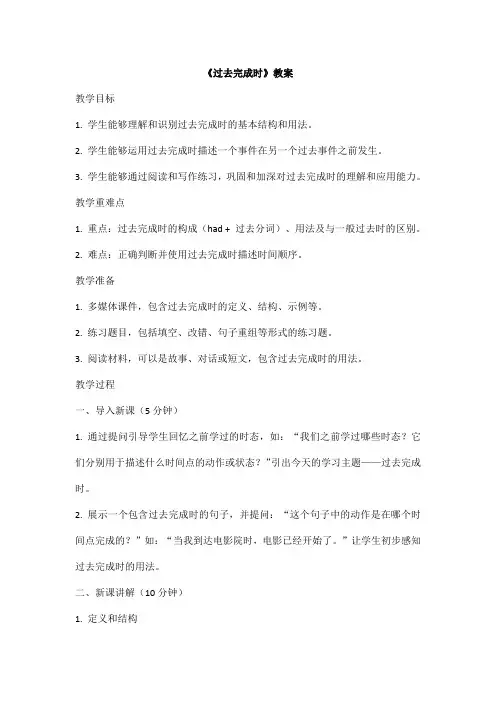
《过去完成时》教案教学目标1. 学生能够理解和识别过去完成时的基本结构和用法。
2. 学生能够运用过去完成时描述一个事件在另一个过去事件之前发生。
3. 学生能够通过阅读和写作练习,巩固和加深对过去完成时的理解和应用能力。
教学重难点1. 重点:过去完成时的构成(had + 过去分词)、用法及与一般过去时的区别。
2. 难点:正确判断并使用过去完成时描述时间顺序。
教学准备1. 多媒体课件,包含过去完成时的定义、结构、示例等。
2. 练习题目,包括填空、改错、句子重组等形式的练习题。
3. 阅读材料,可以是故事、对话或短文,包含过去完成时的用法。
教学过程一、导入新课(5分钟)1. 通过提问引导学生回忆之前学过的时态,如:“我们之前学过哪些时态?它们分别用于描述什么时间点的动作或状态?”引出今天的学习主题——过去完成时。
2. 展示一个包含过去完成时的句子,并提问:“这个句子中的动作是在哪个时间点完成的?”如:“当我到达电影院时,电影已经开始了。
”让学生初步感知过去完成时的用法。
二、新课讲解(10分钟)1. 定义和结构* 定义:“过去完成时表示在过去某一时间或动作之前已经发生或完成的动作或状态。
”* 结构:“had + 过去分词”,如:“I had finished my homework before going out.”2. 用法和示例* 在时间状语从句中:“当我到家时,他们已经离开了。
”(When I got home, they had already left.)* 与before, after等连用:“在昨天之前,我已经读完了这本书。
”(Before yesterday, I had already finished reading this book.)3. 与一般过去时的区别* 一般过去时描述过去某一时间点的动作或状态,而过去完成时则强调这个动作或状态在另一过去动作之前已经发生或完成。
如:“我昨天看了电影。
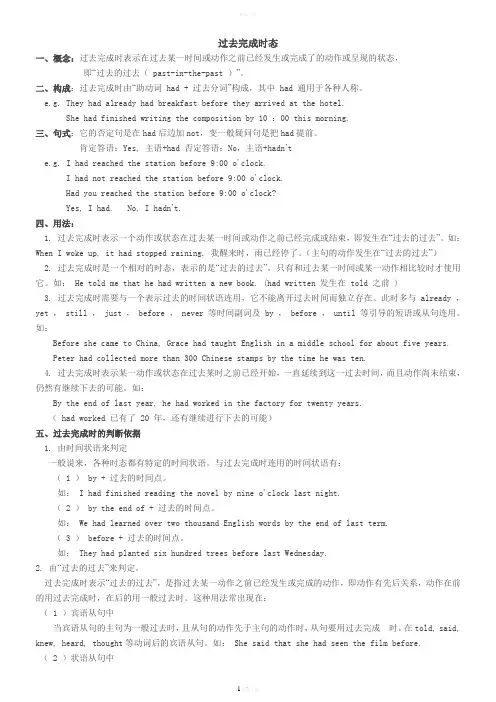
过去完成时态一、概念:过去完成时表示在过去某一时间或动作之前已经发生或完成了的动作或呈现的状态,即“过去的过去( past-in-the-past )”。
二、构成:过去完成时由“助动词 had + 过去分词”构成,其中 had 通用于各种人称。
e.g. They had already had breakfast before they arrived at the hotel.She had finished writing the composition by 10 :00 this morning.三、句式:它的否定句是在had后边加not,变一般疑问句是把had提前。
肯定答语:Yes, 主语+had 否定答语:No,主语+hadn’te.g. I had reached the station before 9:00 o'clock.I had not reached the station before 9:00 o'clock.Had you reached the station before 9:00 o'clock?Yes, I had. No, I hadn’t.四、用法:1. 过去完成时表示一个动作或状态在过去某一时间或动作之前已经完成或结束,即发生在“过去的过去”。
如:When I woke up, it had stopped raining. 我醒来时,雨已经停了。
(主句的动作发生在“过去的过去”)2. 过去完成时是一个相对的时态,表示的是“过去的过去”,只有和过去某一时间或某一动作相比较时才使用它。
如: He told me that he had written a new book. (had written 发生在 told 之前 )3. 过去完成时需要与一个表示过去的时间状语连用,它不能离开过去时间而独立存在。
此时多与 already ,yet , still , just , before , never 等时间副词及 by , before , until 等引导的短语或从句连用。
过去完成时课程设计一、教学目标本课程的教学目标是让学生掌握过去完成时的基本用法,能够准确地运用过去完成时表达过去某个时间点或时间段内已经完成的动作或状态。
具体分为以下三个维度:1.知识目标:学生能够理解过去完成时的概念,掌握其构成和基本用法,了解过去完成时与一般过去时的区别。
2.技能目标:学生能够运用过去完成时进行日常交流,准确地表达过去某个时间点或时间段内已经发生的动作或状态。
3.情感态度价值观目标:通过学习过去完成时,培养学生对英语的兴趣和自信心,提高他们对英语学习的积极性。
二、教学内容本课程的教学内容主要包括过去完成时的概念、构成、用法和与一般过去时的区别。
具体安排如下:1.过去完成时的概念:介绍过去完成时的定义,以及它表示的时间关系。
2.过去完成时的构成:讲解过去完成时的构成,即“had”加上动词的过去分词。
3.过去完成时的用法:通过例句和练习,让学生掌握过去完成时表示的动作发生在过去某个时间点或时间段内的用法。
4.过去完成时与一般过去时的区别:分析过去完成时与一般过去时的异同,并通过练习让学生学会正确选择使用。
三、教学方法为了激发学生的学习兴趣和主动性,本课程将采用多种教学方法,如讲授法、讨论法、案例分析法和任务驱动法等。
1.讲授法:教师通过讲解过去完成时的概念、构成和用法,为学生提供系统的知识体系。
2.讨论法:教师学生进行小组讨论,让学生分享彼此的学习心得,提高他们的口语表达能力。
3.案例分析法:教师提供典型例句和练习,让学生分析并运用过去完成时进行表达,加深他们对知识点的理解。
4.任务驱动法:教师设计实际场景的任务,让学生在完成任务的过程中运用过去完成时,提高他们的实际应用能力。
四、教学资源为了支持教学内容和教学方法的实施,丰富学生的学习体验,我们将选用以下教学资源:1.教材:选用《新概念英语》第二册的相关内容,作为学生学习过去完成时的主要教材。
2.参考书:推荐学生阅读《英语语法大全》等参考书,以加深对过去完成时的理解。
《过去完成时》之微课教学方案过去完成时之微课教学方案
引言
本文档旨在介绍《过去完成时》微课教学方案,帮助学生在研究英语过去完成时时态时更加轻松地掌握相关知识。
目标
通过本教学方案,学生将能够:
- 理解过去完成时的概念和用法
- 正确运用过去完成时进行语言表达
- 分辨过去完成时与其他过去时态的区别
教学内容和方法
1. 概念讲解
- 通过引导学生回顾过去时和现在完成时的知识,引入过去完成时的概念。
- 使用简单明了的例句和图表解释过去完成时的用法和特点。
- 强调过去完成时所描述的动作或状态发生在过去的过去。
2. 语法练
- 提供一些练题,让学生在课堂上进行语法运用练。
- 设计填空题、改错题等形式的练,让学生巩固过去完成时的应用。
3. 情景对话
- 编写几个情景对话,让学生运用过去完成时进行情景模拟对话。
- 鼓励学生使用过去完成时来描述过去的经历和事件。
4. 视频教学
- 提供一段关于过去完成时的精选视频,让学生在观看中更加直观地理解相关概念。
教学评估
为了评估学生对过去完成时的掌握程度,可以设计一些小测验和作业,包括填空题、选择题和简短的书面表达题。
结论
通过本教学方案,学生将能够更好地理解和运用过去完成时,提高英语语法水平。
希望本方案能够对教师们在教授过去完成时时态时提供一些参考和帮助。
过去完成时教案模板第1篇:过去完成时教案过去完成时教案教学目标:知识目标:通过复习使学生巩固有关过去完成时有关知识并能够运用所学知识解决时态的题目。
能力目标:提高学生综合运用所学知识解决问题的能力。
德育目标:通过复习使学生树立较强的自信心,形成克服困难的意志。
重点和难点:1、正确使用过去完成时解决时态问题。
2、过去完成时和一般过去时的区别。
课型:复习课教法:讲解练习相结合教具:课件教学过程一、复习导入1、复习了解英语中的7种时态。
2、结合历届高考试题分析对时态知识的考察情况。
何时态都是“时间”与“动作的意义”的结合。
过去完成时的时间很明显是“过去”;其动作的意义就是已经发生,换句话说就是完成了的情况。
复习时应注意四点。
二.结构过去完成时的基本结构是:“had + 动词的过去分词”。
例如:I had learned 2,000 English words by the end of last term.到上学期期末为止我已经学了2,000个英语单词。
三.实质过去完成时表示在过去了的某个时间或动作之前所发生的动作,其实质就是“过去的过去”。
例如:When the teacher came into the claroom,Liu Hong had gone home.当老师走进教室时,刘红已经回家了。
(“回家”发生在过去的动作“走进”之前)四.搭档1.“介词by +含一般过去时态的句子”。
介词by 本身表示“在……之前;到……为止”。
例如:Edison had built a chemistry lab by the time he was ten.爱迪生十岁的时候就已经建立了一个化学实验室。
2.“时间状语从句”。
例如:When my mother got home,I had already done 10 maths problems.当妈妈到家时,我已经做了十道数学题。
3.“宾语从句”或“间接引语”。
教案学习如何使用过去完成时态过去完成时态是英语中的一种时态,它用来表示过去某个时间点或动作之前已经完成的动作。
在教案学习中,了解如何使用过去完成时态对于教师来说是非常重要的,因为它可以帮助他们在教学中更准确地描述过去的事件和经历。
本文将介绍过去完成时态的用法和例句,并提供一些教案学习中使用过去完成时态的实例和方法。
过去完成时态的基本结构是“had + 过去分词”,它表示在过去的某个时间或动作之前已经发生或完成的动作。
过去完成时态常常与过去简单时态一起使用,以明确动作发生的先后顺序。
一、用法:1. 表示过去某个时间点之前已经完成的动作或状态。
例句:- By the time they arrived, I had already finished my homework.(他们到达的时候,我已经完成作业了。
)- When she woke up, her parents had already left.(她醒来时,她的父母已经离开了。
)2. 表示在过去某个时间段之前已经发生的动作或状态。
例句:- He had lived in New York for five years before he moved to London.(他在搬到伦敦之前曾在纽约生活了五年。
)- She had known him since they were in high school.(自从他们在高中时她就认识他了。
)二、教案学习中使用过去完成时态的实例:1. 提问学生已完成的动作:教师可以使用过去完成时态来询问学生过去某个时间点之前已经完成的动作,以巩固学生对该时态的理解。
例句:- Had you finished your homework before you went to bed last night?(昨晚你睡觉前完成作业了吗?)- How many books had you read before you started university?(在你开始大学之前,你已经读了多少本书了?)2. 描述过去的经历:使用过去完成时态可以帮助教师更生动地描述过去的经历,使学生更好地理解故事情节或历史事件的发展。
一、教学目标:1. 让学生理解过去完成时的概念和用法。
2. 培养学生运用过去完成时进行日常交流的能力。
3. 提高学生对英语时态的掌握程度。
二、教学内容:1. 过去完成时的定义和构成。
2. 过去完成时的基本用法。
3. 过去完成时与一般过去时的区别。
三、教学重点与难点:1. 过去完成时的构成。
2. 过去完成时的用法。
3. 过去完成时与一般过去时的区别。
四、教学方法:1. 交际法:通过情景模拟和角色扮演,让学生在实际语境中运用过去完成时。
2. 任务型教学法:通过完成各种任务,培养学生运用过去完成时的能力。
3. 对比法:通过对比过去完成时和一般过去时,让学生更好地理解两者之间的区别。
五、教学步骤:1. 引入:通过提问引导学生思考过去发生的事情,引出过去完成时的概念。
2. 讲解:讲解过去完成时的定义、构成和基本用法。
3. 练习:让学生进行过去完成时的句子练习,巩固所学知识。
4. 任务:布置任务,让学生在实际语境中运用过去完成时。
6. 作业:布置作业,让学生进一步巩固过去完成时的用法。
六、教学评价:1. 以小组讨论的形式,让学生用过去完成时态编写一个小故事,并互相分享。
2. 教师选取几个学生的作品,进行展示和点评,重点关注过去完成时的正确使用。
3. 针对学生的课堂表现和作业完成情况,评估学生对过去完成时的掌握程度。
七、教学拓展:1. 引导学生思考过去完成时在现实生活中的应用,例如:看影视剧、阅读小说等。
2. 让学生尝试用过去完成时态编写日记,提高运用所学知识的能力。
3. 组织一次过去完成时态的主题活动,如:过去完成时态辩论赛、过去完成时态知识竞赛等。
八、教学资源:1. PPT课件:内容包括过去完成时的定义、构成、用法等。
2. 练习题:提供多种形式的练习题,让学生巩固过去完成时的知识点。
3. 情景剧:制作一段关于过去完成时的情景剧,帮助学生更好地理解用法。
4. 参考资料:提供一些关于过去完成时的文章和案例,供学生课后阅读。
过去完成时课程设计一、课程目标知识目标:1. 学生能够理解过去完成时的概念和构成,掌握其基本用法,如过去某一时间点或动作之前已经完成的动作或状态。
2. 学生能够区分过去完成时与其他时态,如一般过去时、现在完成时的区别,并能在实际语境中正确运用。
3. 学生通过学习过去完成时,回顾并巩固过去时的相关知识,形成系统的语法知识体系。
技能目标:1. 学生能够在口语和书面表达中,熟练运用过去完成时描述过去的事件,提高语言表达的准确性和连贯性。
2. 学生通过小组讨论、情景剧表演等形式,锻炼合作能力,提高在实际语境中运用过去完成时的能力。
情感态度价值观目标:1. 学生在学习过程中,培养对英语语法学习的兴趣和热情,树立自信心,克服对语法的恐惧感。
2. 学生通过学习过去完成时,学会关注和描述过去的事件,培养尊重历史、珍惜当下的价值观。
3. 学生在小组活动中,学会倾听他人意见,尊重他人,培养团队协作精神。
课程性质:本课程为英语语法教学,重点讲解过去完成时。
考虑到学生的年龄特点和认知水平,课程设计注重实际语境的创设,激发学生的学习兴趣。
学生特点:学生处于中学阶段,具有一定的英语基础,但语法知识掌握程度不一,需要针对性的教学和指导。
教学要求:教师应关注学生的个体差异,采用多样化的教学手段,确保学生在理解过去完成时的基础上,能够熟练运用,提高英语综合运用能力。
同时,注重培养学生的合作精神,提高其情感态度价值观。
在教学过程中,分解课程目标,关注学生的学习成果,为后续教学设计和评估提供依据。
二、教学内容本节课以教材中关于过去完成时的章节为基础,涵盖以下内容:1. 过去完成时的基本概念与构成:通过讲解,使学生理解过去完成时的定义,掌握其构成(had + 过去分词)。
2. 过去完成时的用法:讲解过去完成时在不同情境下的运用,如表示过去某一时间点之前已经完成的动作,或表示过去某一动作之前已经完成的另一动作。
- 与一般过去时的对比:通过实例分析,使学生区分过去完成时与一般过去时的使用场景。
过去完成时态
一、概念:过去完成时表示在过去某一时间或动作之前已经发生或完成了的动作或呈现的状态,
即“过去的过去(past-in-the-past )”。
二、构成:过去完成时由“助动词had + 过去分词”构成,其中had 通用于各种人称。
e.g. They had already had breakfast before they arrived at the hotel.
She had finished writing the composition by 10 :00 this morning.
三、句式:它的否定句是在had后边加not,变一般疑问句是把had提前。
肯定答语:Yes, 主语+had 否定答语:No,主语+hadn’t
e.g. I had reached the station before 9:00 o'clock.
I had not reached the station before 9:00 o'clock.
Had you reached the station before 9:00 o'clock?
Yes, I had. No, I hadn’t.
四、用法:
1. 过去完成时表示一个动作或状态在过去某一时间或动作之前已经完成或结束,即发生在“过去的过去”。
如:When I woke up, it had stopped raining. 我醒来时,雨已经停了。
(主句的动作发生在“过去的过去”)
2. 过去完成时是一个相对的时态,表示的是“过去的过去”,只有和过去某一时间或某一动作相比较时才使用
它。
如:He told me that he had written a new book. (had written 发生在told 之前)
3. 过去完成时需要与一个表示过去的时间状语连用,它不能离开过去时间而独立存在。
此时多与already ,yet ,still ,just ,before ,never 等时间副词及by ,before ,until 等引导的短语或从句连用。
如:Before she came to China, Grace had taught English in a middle school for about five years.
Peter had collected more than 300 Chinese stamps by the time he was ten.
4. 过去完成时表示某一动作或状态在过去某时之前已经开始,一直延续到这一过去时间,而且动作尚未结束,
仍然有继续下去的可能。
如:
By the end of last year, he had worked in the factory for twenty years.
(had worked 已有了20 年,还有继续进行下去的可能)
五、过去完成时的判断依据
1. 由时间状语来判定
一般说来,各种时态都有特定的时间状语。
与过去完成时连用的时间状语有:
( 1 )by + 过去的时间点。
如:I had finished reading the novel by nine o'clock last night.
( 2 )by the end of + 过去的时间点。
如:We had learned over two thousand English words by the end of last term.
( 3 )before + 过去的时间点。
如:They had planted six hundred trees before last Wednesday.
2. 由“过去的过去”来判定。
过去完成时表示“过去的过去”,是指过去某一动作之前已经发生或完成的动作,即动作有先后关系,动作在前
的用过去完成时,在后的用一般过去时。
这种用法常出现在:
( 1 )宾语从句中
当宾语从句的主句为一般过去时,且从句的动作先于主句的动作时,从句要用过去完成时。
在told, said, knew, heard, thought等动词后的宾语从句。
如:She said that she had seen the film before.
( 2 )状语从句中
在时间、条件、原因、方式等状语从句中,主、从句的动作发生有先后关系,动作在前的,要用过去完成时,
动作在后的要用一般过去时。
如:
When I got to the station, the train had already left.
After he had finished his homework, he went to bed.
注意:before, after 引导的时间状语从句中,由于before 和after 本身已表达了动作的先后关系,若主、
从句表示的动作紧密相连,则主、从句都用一般过去时。
如:
Where did you study before you came here?
After he closed the door, he left the classroom.
3. 表示意向的动词,如hope, wish, expect, think, intend, mean, suppose等,用过去完成时表示"原本…,未能…"
e.g. We had hoped that you would come, but you didn't.
4. 根据上、下文来判定。
e.g. I met Wang Tao in the street yesterday. We hadn't seen each other since he went to Beijing.
六、过去完成时与现在完成时的区别
现在完成时表示的动作发生在过去,但侧重对现在产生的结果或造成的影响,与现在有关,其结构为“助动词have (has) + 过去分词”;过去完成时则是一个相对的时态,它所表示的动作不仅发生在过去,更强调“过去的过去”,只有和过去某时或某动作相比较时,才用到它。
试比较:
I have learned 1000 English words so far.
到目前为止我已经学会了1000 个英语单词。
I had learned 1000 English words till then.
到那时为止我已经学会了1000 个英语单词。
— I'm sorry to keep you waiting. 对不起,让你久等了。
— Oh, not at all. I have been here only a few minutes.
没什么,我只等了几分钟。
(“等”的动作从过去某一时间点持续到现在)
— John returned home yesterday. 约翰昨天回到家的。
— Where had he been?
他去哪儿了?(答语中使用过去完成时是指约翰在returned home 之前去了哪些地方,
即“过去的过去”)
七、过去完成时与一般过去时的区别
虽然这两种时态都表示过去发生的动作或存在的状态,但在使用时应注意以下几点:
1. 时间状语不同:过去完成时在时间上强调“过去的过去”;而一般过去时只强调过去某一特定的时间。
试
比较:
They had arrived at the station by ten yesterday.
They arrived at the station at ten yesterday.
2. 在没有明确的过去时间状语作标志时,谓语动词动作发生的时间先后须依据上下文来判断:先发生的用过去完成时,后发生的则用一般过去时。
如:
She was very happy. Her whole family were pleased with her, too.
She had just won the first in the composition competition.
3. 当两个或两个以上接连发生的动作用and 或but 连接时,按时间顺序,只需用一般过去时来代替过去完成时;另外,在before ,after ,as soon as 引导的从句中,由于这些连词本身已经表示出时间的先后,因此也
可以用过去时来代替过去完成时。
如:
He entered the room, turned on the light and read an evening paper.
I (had) called her before I left the office.。